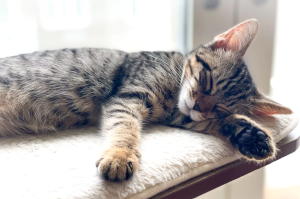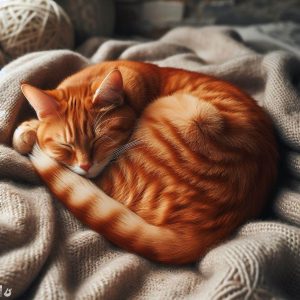Have you ever wondered why your feline friend is giving you the silent treatment when it comes to purring? As a cat parent, hearing your kitty purr is one of the most rewarding and soothing sounds. But what if your cat has stopped purring altogether or never purred in the first place? Don’t worry, you’re not alone! Many cat owners are puzzled when their cats don’t purr and want to get to the bottom of this mysterious behavior.
In this guide, we’ll dive deep into all the possible reasons your cat is not purring and provide tips to get them purring again in no time. I have researched the top expert sources to uncover the facts, statistics, and solutions to help unravel the mystery of the missing purr. So curl up, get your notepad ready, and let’s get started!
Why Won’t My Cat Purr? 7 Common Reasons Explored
Cats purr for many reasons—to communicate contentment, during nursing, or even when injured or sick as a self-soothing mechanism. So when your cat stops purring suddenly, it could signify an underlying issue. Understanding the science behind purring and the circumstances that silence it can help you address the problem.
Here are the 7 most common reasons why cats don’t purr explained…
1. Illness or Pain
This is one of the top reasons for a lack of purring. Cats tend to stop purring when unwell or in pain. Even minor discomfort from conditions like dental disease, bladder infections, or arthritis can inhibit purring.
Veterinarians reveal kitties also stop purring within 24 hours of developing an upper respiratory infection. So loss of purring can indicate the early stages of an illness.
Look out for other symptoms like lethargy, reduced appetite, vomiting, or inappropriate urination/defecation. It’s best to get your cat checked by a vet asap. Early treatment improves recovery.
2. Stress or Anxiety
Cats are sensitive creatures and can get stressed by change. Situations like introducing a new pet, moving homes, traveling, or loud environments can trigger stress and anxiety. This leads to decreased purring.
High-stress levels also suppress their appetite, so watch out for reduced food intake. Try to minimize stressful stimuli and make your cat feel secure. Maintain routines, give them a safe space, and use calming aids like pheromone diffusers/sprays.
3. Old Age
As cats grow older, diseases like hyperthyroidism or kidney disease can develop, causing discomfort. Joint conditions like arthritis also crop up, inhibiting purring.
Senior cats aged 11+ years are at higher risk for these age-related issues, which impact their quality of life. Regular senior wellness exams allow early diagnosis and treatment to relieve any pain and get those purrs rumbling again!
4. Trauma or Abuse
Cats who have endured abuse, trauma, or neglect can become fearful and withdrawn. This stressful background switches off their vocalizations.
With patience, you can help rebuild their confidence. Use positive reinforcement training and establish yourself as a source of comfort. Over time, they will learn to trust again and purr happily in your presence.
5. Hearing Loss
Research reveals most cats rely heavily on auditory feedback to control their purring. So hearing impairment, either congenital or age-related, can affect their vocal abilities.
Signs like lack of response to sounds or voices, disorientation, and increased meowing/yowling indicate hearing issues. Seek advice from your veterinarian as soon as you suspect any problems.
6. Communication Style
Breed traits influence communication tendencies, so some cats are just less vocal than others.
For instance, Siamese and Burmese breeds are more talkative, while Persian and Ragdoll cats tend to purr less even when content. So a cat’s genetic makeup affects their purring habits.
If your quiet kitty shows other signs of happiness like kneading, bunting, or a raised tail, they probably enjoy your company even sans purrs!
7. Lack of Bonding
Cats purr during social interactions as a bonding mechanism and show of affection. So cats who are poorly socialized or have experienced little human interaction since kittenhood may not purr when petted or around their owners.
Building trust through play, treats, and positive cuddling sessions can help strengthen your bond so they feel safe enough to purr.
Now that you know why your cat may have stopped purring, let’s look at ways to get them purring again…
7 Tips to Get Your Cat Purring Again
If your cat has stopped purring suddenly or never purred in the first place, try these expert tips to rekindle their soothing rumbly purrs:
1. Identify and Address Underlying Health Issues
As discussed earlier, undiagnosed pain or illness is the #1 reason for lack of purring. So the first step is always a proper medical workup.
- Observe symptoms – Lethargy, reduced appetite/grooming, inappropriate urination, etc. can indicate sickness.
- Get regular senior checks – Senior cats aged 11+ years need twice-yearly wellness exams to catch problems early.
- Discuss concerns promptly with your vet – They’ll carry out a physical exam, diagnostic tests if required, and recommend suitable treatment.
- Follow treatment and aftercare guidelines – Give all medications as prescribed to help your kitty recover fully.
Relieving any discomfort will remove barriers to purring. But you still need to employ additional tactics to restart their rumbly motors.
2. Reduce Stress with Calming Strategies
To relieve anxiety that inhibits purring:
- Identify and remove stressors – Limit loud noises, introduction of new pets, visitors, etc.
- Maintain routines for feeding, play, litter box – Cats dislike unpredictability and change.
- Give them safe spaces – Provide hiding spots, cat trees, and high perches.
- Try calming supplements – Feline pheromones, catnip, hemp oils can relieve stress.
- Consider anti-anxiety medication – For extremely anxious cats, your vet may prescribe meds.
3. Rebuild Trust Through Bonding
For scared, traumatized, or unsocialized cats:
- Initially respect their space – Don’t force interactions, allow them to come to you.
- Offer high-value treats when they approach – Positive reinforcement builds confidence.
- Set up calming play sessions using toys like feathers on string wands.
- Pet gently once they allow handling – Avoid overstimulation.
- Introduce catnip or silvervine – These can lower inhibitions.
- Be loving yet patient – It takes time for them to overcome fear. But your kindness will convince them they’re finally safe.
4. Check for Hearing Troubles
If your cat seems unable to hear or localize sounds:
- Observe response to noises/voices – Do they react or need excessive coaxing?
- Get a hearing exam done by your vet – They’ll check for ear infections and test responses.
- Discuss medication or hearing aids – Treatment options for age-related deafness.
- Adjust interaction cues – Rely more on visual and physical cues, vibrations to get their attention.
5. Accept Breed Traits
Certain breeds are genetically predisposed to be less vocal:
- Persians tend to purr only when solicited for attention.
- Ragdolls reserve purring for very familiar humans.
- Sphynx cats purr selectively.
- Manx cats purr less owing to lack of tail length.
- Bengals chirp more than purr.
So consult your breeder or research typical traits. If your cat displays other signs of contentment, take comfort from that!
6. Check for Obstructions in Throat/Nose
Blockages in the nasal cavity or throat can mechanically inhibit purring:
- Look for nasal discharge or excessive sneezing indicating infection.
- Feel for throat swelling carefully.
- Watch for difficulty swallowing/breathing – These require immediate vet attention!
- Get x-rays done if issues persist – To check for polyps, masses, or foreign bodies.
- Removing any obstructions will instantly revive purring. But do get veterinary guidance for appropriate treatment.
7. Use Purr-Encouraging Tactics
Some ways to elicit happy purrs:
- Brush regularly – Most cats relish a good brushing session.
- Offer chin scratches – Being scratched under the chin and cheeks releases endorphins.
- Massage head and cheeks – Gently rub their face, ears, temples in small circles.
- Pet in preferred areas like under the chin or base of tail.
- Warm hands before petting – Cats like warm human touch.
- Keep sessions short initially – Don’t overstimulate anxious cats.
- Try interactive toys like wands and laser pointers – Playful interaction lightens their mood.
- Chatter to them – They recognize and respond to human vocalizations.
With this 7-step troubleshooting guide, you can get to the root of your cat’s reduced purring and take steps to get them rumbling happily again. But do consult your veterinarian if issues persist or other signs of illness arise. Now purr away!
Why Do Cats Purr? Science-backed Hypotheses Explored
Before figuring out why your cat doesn’t purr, it helps to first understand why cats purr at all. Feline vocalizations like meowing or yowling are easier to comprehend, but just why do cats purr? Scientists are still trying to unravel the mystery behind purring fully, but research points to some key theories:
1. Communication of Contentment
This is the most widely accepted hypothesis. Cats purr to communicate comfort, security, and contentment.
Kittens purr to show affection toward their mother. Adult cats purr during petting or feeding to indicate positive emotions. It’s a social signaling mechanism, like a hug between friends!
2. Pain Relief
Interestingly, cats have been recorded purring not only when happy but also when injured or sick.
Research reveals purring releases endorphins which act as natural painkillers. The 25-150 Hz frequencies may also promote bone density and healing.
So cats likely purr as a self-soothing mechanism during distress – like calming music for humans!
3. Thermoregulation
Some experts suggest purring helps cats regulate body temperature.
The rapid diaphragm and larynx vibrations generate heat, allowing cats to warm themselves. This might explain increased purring during nursing or cold environments.
4. Communication with Kittens
Kittens are born blind and deaf, so mothers communicate with them through purring.
The vibrations drawn in while nursing guide kittens to the milk source. This helps form an early social bond.
5. Signaling Safety
For fearful cats, purring signals a safe situation where they can lower their guard. This requires high levels of trust in the company.
So try to build consistent positive experiences to help anxious cats associate you with safety and comfort.
While researchers are still piecing together the science behind it, the fact remains – purring indicates a happy, healthy cat! Knowing why cats purr gives more insight into why individual cats may show deviations in this behavior.
Cat Purring Facts and Statistics
Now that we’ve explored some hypotheses behind why cats purr, here are some interesting feline purring facts and statistics:
- Cats purr at frequencies of 25 to 150 Hertz, spanning the same healing frequencies used in medicine like ultrasound therapy.
- Kittens begin purring at around 2 days old, indicating an innate rather than learned ability.
- The exact anatomical mechanism behind purring still confuses scientists. It likely involves combined signaling from the brain to the larynx and diaphragm.
- While most cats purr, big cats like lions, cheetahs, leopards and others cannot purr. They roar and meow, though!
- Studies reveal domestic cats purr most often on average while being petted (75% of the time), followed by while eating (25%) and while grooming themselves (25%).
- Purring is not always voluntary – cats have been recorded purring while under anesthesia! So it can be an involuntary response.
- Siamese cats purr less (only 20% of the time) than other breeds according to research. Oriental cats also tend to purr less.
- The Manx cat purrs least frequently of all breeds. Their naturally short or missing tail makes it harder to purr.
- Stressed cats purr at lower frequencies around 27-44 Hertz compared to contented purrs of 25-150 Hertz range.
So in essence, purring is a complex innate communication behavior that reveals a cat’s emotional state and social intent. Familiarizing yourself with your cat’s unique purring tendencies can provide valuable insights into their health and happiness.
When to See the Vet for Lack of Purring
While you can try many tactics outlined here to restart purring at home, it’s crucial to seek veterinary help if certain red flags arise. Contact your vet promptly if your cat:
- Has suddenly stopped purring after purring normally in the past
- Displays other symptoms like lethargy, reduced appetite, weight loss, inappropriate urination/defecation
- Cries or demonstrates pain when touched at a certain body part
- Has respiratory distress like open-mouth breathing or constant coughing
- Has swelling or lumps in their throat region obstructing purring
- Has green or yellow discharge from nose or eyes, indicating infection
- Is a senior cat who may have age-related issues causing discomfort
- Fails to revive purring despite your best efforts at home using calming and bonding techniques
Veterinarians are trained to pick up on subtle signs of disease and conduct thorough diagnostic workups. Getting to the root of any underlying medical issue and managing pain or infection will pave the way for your cat to rediscover its purr-fect voice. Better safe than sorry!
The Takeaway: Understanding Your Cat’s Purrs (and Lack Thereof!)
In a nutshell:
- Purring is a unique feline vocalization signalling contentment but also used for pain relief.
- Common reasons for lack of purring include illness, stress, old age, trauma, communication styles, and lack of bonding.
- Tactics like addressing medical issues, reducing anxiety, rebuilding trust through play and calming aids, and positive reinforcement can restart purring.
- Consult a vet promptly if your cat stops purring suddenly or shows other signs of potential illness or injury.
So stay observant of fluctuations in your cat’s purring habits as it can provide valuable clues to their health and happiness. With time and patience, you can get even the most reticent kitty to unleash its soothing inner motor! Just apply these handy tips and shower them with lots of love.




